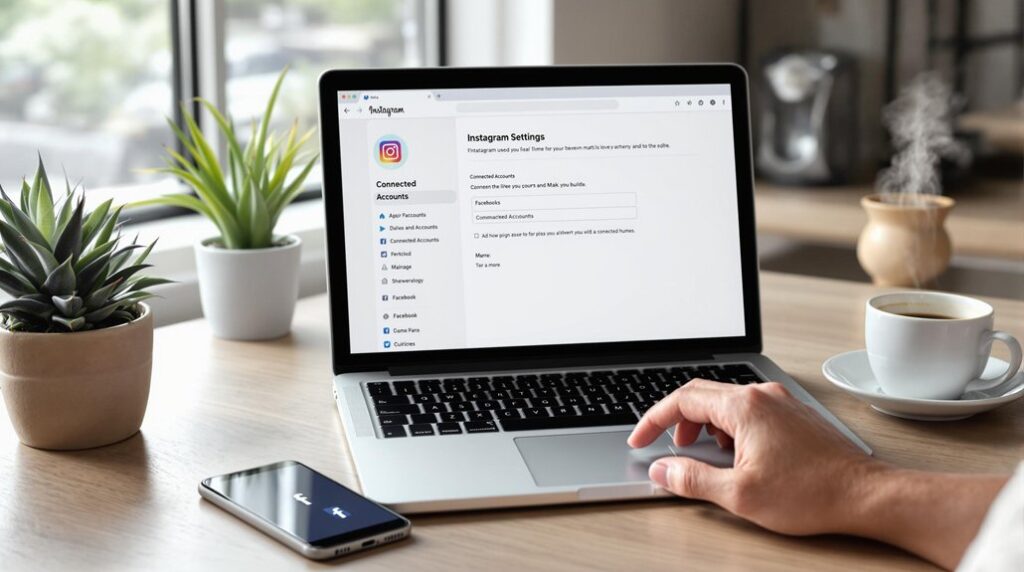Creating high-converting Facebook ads hinges on defining specific goals like purchases or sign-ups and tailoring your ad to one objective. Understand your target audience by researching demographics, interests, and behaviors to create personalized messaging. Utilize interest-based targeting and test different ad placements to optimize engagement. Craft compelling lead magnets offering valuable content and design high-converting landing pages with strong CTAs. Use high-quality visuals and persuasive ad copy, and set up conversion tracking with Facebook Pixel to monitor performance. By consistently analyzing performance data and making informed adjustments, you can greatly enhance your ad's effectiveness. Discover actionable strategies for each step.
Key Takeaways
- Define specific conversion goals and tailor ads to focus on one goal for better results.
- Research and segment your target audience based on demographics, interests, and behaviors.
- Utilize interest-based targeting to connect with users likely to engage and convert.
- Craft compelling ad creatives with high-quality visuals, clear messaging, and strong CTAs.
- Set up Facebook Pixel for detailed conversion tracking and retargeting.
Define Your Conversion Goals
To create high-converting Facebook ads, start by defining specific conversion goals like View Content, Add to Wishlist, Initiate Checkout, or Purchase. Establishing clear conversion goals is vital for conversion optimization and guarantees your campaign's success.
Tailoring your ads to focus on one specific goal yields better results than a generic approach. For instance, if your goal is 'Purchase,' every element of your ad—from the creative to the call-to-action—should drive users toward completing a purchase.
Facebook offers robust tools like Custom Conversions to help you define and track these goals effectively. Custom conversion events let you pinpoint exactly when and how users engage with your ads, providing invaluable data for refining your strategy. By leveraging these tools, you can adjust your targeting strategies to better connect with potential customers who are more likely to convert.
Moreover, understanding and defining your conversion goals allows you to segment your audience more accurately. This precise segmentation enhances your targeting strategies, ensuring your ads reach the right people at the right time.
Ultimately, focusing on specific conversion goals not only streamlines your efforts but also maximizes your return on investment, making your Facebook ads far more effective.
Research Your Target Audience
Understanding your audience's demographics, interests, and behaviors is the cornerstone of creating Facebook ads that truly resonate and drive conversions. By leveraging Facebook's tools, you can access valuable audience insights without needing personal information. This data helps you understand demographics and identify interests, ensuring your ads are tailored to your target market.
Here's a quick overview of key audience research elements:
| Factor | Description | Benefit |
|---|---|---|
| Demographics | Age, gender, education, and location | Pinpoint who will see your ads |
| Interests | Hobbies, favorite activities, and preferences | Craft ads that appeal to passions |
| Behaviors | Purchase history, device usage, and online habits | Predict and influence future actions |
| Engagement Rates | Likes, shares, and comments on similar content | Measure and optimize ad relevance |
By understanding demographics, you can guarantee your ads reach the right age group, gender, and location. Identifying interests allows you to tailor your creative content to what your audience cares about. Additionally, analyzing behaviors helps you predict actions and deliver ads at strategic times.
Targeting specific audiences not only increases engagement but also boosts click-through rates. Tailoring your ads to resonate with your audience's interests and desires maximizes ad performance and conversion rates. This data-driven approach is essential for creating high-converting Facebook ads.
Interest-Based Targeting
Leveraging interest-based targeting on Facebook allows you to connect with users who are more likely to engage with your ads and convert into customers. By focusing on specific interests, like fans of Starbucks, you can increase your engagement and conversion rates greatly. This approach relies on behavioral targeting, enabling you to reach a more relevant audience by aligning your ads with their interests and activities.
First, create detailed customer personas to understand the interests and behaviors of your ideal audience. This helps in pinpointing the exact interests that resonate with them.
Next, perform competitor analysis to identify the interests of users already engaged with similar brands. This insight aids in fine-tuning your audience segmentation, ensuring that your ads reach pre-qualified leads who are more likely to convert.
Utilize Facebook's robust targeting capabilities to segment your audience by location, age, gender, interests, relationship status, and education. Tailor your ads to match these specific interests, leading to higher conversion rates and engagement.
Choose the Right Ad Placement
Choosing the right ad placement on Facebook can greatly enhance your conversion rates and overall ad performance. Different placements like the news feed, right column, Instagram, and Messenger each have unique advantages. Mobile news feed often outperforms other placements due to high mobile usage. Conducting a thorough placement analysis will help you understand where your audience engages the most, leading to better ad optimization.
Testing various placements is essential for identifying which ones work best for your specific audience. Here's a quick breakdown of key placements and their potential:
| Placement | Audience Engagement | Mobile Performance |
|---|---|---|
| News Feed | High | Excellent |
| Right Column | Moderate | Limited |
| High | Excellent | |
| Messenger | Moderate | Good |
When you analyze placement performance, look at metrics like click-through rates and conversions. This data-driven approach helps you fine-tune your ad placements for maximum impact. Optimizing placements not only boosts conversion rates but also ensures your ad budget is spent effectively.
Craft Compelling Lead Magnets
To effectively boost your conversion rates with Facebook ads, crafting compelling lead magnets that address your audience's specific pain points is vital. Offering eBooks, webinars, or free trials can greatly increase your email subscribers and leads. The key to lead magnet effectiveness lies in providing valuable content that resonates with your target audience's needs and desires.
When your lead magnets directly tackle the issues your audience faces, they become irresistible, driving higher conversions and enhancing the overall impact of your Facebook ads.
Clear and concise messaging about your lead magnet's benefits is essential. Make sure your audience immediately understands the value they'll receive, which in turn boosts audience engagement and leads them to take action.
Moreover, data-driven insights indicate that well-crafted lead magnets not only attract potential customers but also keep them engaged. For instance, a study found that lead magnets offering highly relevant content saw a 50% higher conversion rate compared to generic offers.
Build High-Converting Landing Pages
Crafting high-converting landing pages starts with a clear, compelling call-to-action (CTA) that aligns seamlessly with your ad copy. This harmony ensures that users encounter consistent messaging, which enhances user experience and boosts your conversion rates.
A well-designed landing page should immediately draw users in with a strong headline and engaging copywriting. Don't forget to optimize your CTA using strategic placement and enticing language.
To maximize conversions, focus on landing page design that's clean, aesthetically pleasing, and easy to navigate. Simplicity is key; avoid clutter and keep the user's journey straightforward. Mobile responsiveness is crucial—over half of Facebook users access the platform via mobile. Guarantee your landing page looks and functions perfectly on all devices.
A/B testing is essential for landing page optimization. Test different elements such as headlines, images, and CTAs to see what performs best. Tailoring your landing pages specifically for Facebook leads can also greatly improve your results.
Design Effective Ad Creatives
Effective ad creatives are pivotal in capturing the attention of your target audience and driving conversions. To create high-converting Facebook ads, focus on these essential elements:
- Visual Appeal: Use color psychology to influence emotions and actions. For example, blue can evoke trust, while red can create a sense of urgency. Choosing the right colors can greatly boost your ad's effectiveness.
- Storytelling: Utilize visual storytelling to connect with your audience on an emotional level. A compelling narrative can make your ad memorable and relatable, increasing the likelihood of conversion. Show, don't just tell—use images and videos to convey your message powerfully.
- Ad Formats: Experiment with various ad formats like images, videos, and carousels. Each format has its strengths; videos can be more engaging, while carousels allow you to showcase multiple products or features. Testing different formats helps determine what resonates best with your audience.
- Clear Copy: Your ad copy should be clear and concise, directly addressing the needs and desires of your audience. Effective copywriting speaks to the benefits of your product or service, prompting users to take action.
Implement Conversion Tracking
Implementing conversion tracking is essential for measuring your ad's effectiveness. Start by setting up the Facebook pixel to gather data.
Then, define clear conversion goals to align with your business objectives. Use this data to analyze performance and optimize your strategy.
Ensuring you focus on what drives the highest ROI is crucial for the success of your advertising efforts.
Set Up Pixel
To maximize your ad performance and gain valuable insights into user actions, start by setting up the Facebook Pixel for detailed conversion tracking. This tool is essential for any serious marketer aiming for pixel optimization and effective conversion tracking strategies. Here's how to get started:
- Install the Pixel Code: Add the Facebook Pixel code to your website's header. This enables the Pixel to track key actions like purchases, sign-ups, and page views.
- Configure Standard Events: Set up standard events within the Pixel to track specific user actions. These can include 'Add to Cart', 'Complete Registration', and 'Purchase'. Standard events provide precise data for optimizing your ads.
- Custom Conversions: Define custom conversions to track unique actions that are pivotal to your business. Custom conversions offer deeper insights into your users' behaviors, aiding in more effective ad targeting.
- Enable Retargeting: Use the Pixel data to retarget users who've previously interacted with your website or ads. Retargeting boosts your chances of converting warm leads into customers.
Define Conversion Goals
Establishing specific conversion goals for your Facebook Ads campaign is vital for tracking and optimizing user actions that align with your business objectives. By defining clear goals such as View Content, Add to Wishlist, Initiate Checkout, or Purchase, you create a roadmap for conversion optimization. Understanding and implementing these goals allows you to measure the effectiveness of your ads and make data-driven decisions to enhance your strategy.
Utilize Facebook's custom conversion events feature to track and optimize for these specific goals. This tool lets you tailor your conversion tracking to match your unique business objectives, ensuring your advertising efforts are precisely targeted. Goal setting is essential; it not only helps in tracking but also in refining your campaigns to achieve better results.
With clearly defined conversion goals, you can drive meaningful actions from your audience, maximizing your ROI. You'll be able to identify which ads are performing well and which need adjustments, leading to a more efficient allocation of your ad spend.
Analyze Performance Data
By leveraging the power of Facebook's conversion tracking tools, you can secure sharp insights into user actions post-ad interaction, driving precise and data-backed optimizations. By implementing conversion tracking, you can measure essential actions like purchases, sign-ups, or page views, which are key indicators of your ad performance.
To effectively analyze performance data, follow these steps:
- Set Up Facebook Pixel: Install the Facebook Pixel on your website to track user behavior across devices. This pixel collects data that helps you understand how users interact with your ads and website.
- Define Conversion Events: Identify and set up specific conversion events, such as completed purchases or newsletter sign-ups. This will enable you to measure actions that matter most to your business goals.
- Implement A/B Testing Strategies: Use A/B testing strategies to compare different ad creatives, audiences, and placements. Data analysis from these tests will guide you in optimizing your campaigns for maximum effectiveness.
- Analyze Conversion Data: Dive deep into the conversion data to uncover patterns and insights. Look for trends in user behavior and ad performance to refine your behavioral targeting strategies.
Executing these steps ensures you're making data-driven decisions, measuring ROI accurately, and continually optimizing for higher conversions.
Monitor and Optimize Campaigns
Keeping a close eye on key metrics like click-through rates and conversion rates is essential for gauging the effectiveness of your Facebook ad campaigns. Performance analysis allows you to track how well your ads are engaging your audience and driving desired actions. By regularly monitoring these metrics, you'll gain valuable insights into what's working and what needs improvement.
Optimization strategies are vital for refining your campaigns. Start by A/B testing different ad variations to see which ones resonate most with your audience. This helps you understand preferences and tailor your ads for maximum impact. Continuously tweak elements such as headlines, images, and calls-to-action based on performance data.
Don't forget to evaluate your return on ad spend (ROAS). This metric will tell you if your campaigns are generating enough revenue to justify your investment. If your ROAS is low, consider reallocating your budget to higher-performing ads or trying new targeting options.
Frequently Asked Questions
How to Increase Conversion in Facebook Ads?
You can increase conversion in Facebook ads by focusing on audience segmentation to target the right people and crafting compelling ad copy that resonates. Test variations and optimize based on data to maximize effectiveness and drive results.
What Is a High Conversion Rate for Facebook Ads?
A high conversion rate for Facebook ads, according to industry standards and conversion benchmarks, is 10-25%. Top-performing ads can hit 20% or higher, showing the importance of optimizing your ad creative and targeting strategy.
How Do I Set up Conversions on Facebook Ads?
To set up conversions on Facebook Ads, use custom events for precise conversion tracking. Define actions like purchases or sign-ups within Ads Manager. This approach provides valuable insights, enhancing your campaign's success and driving better results.
How to Create Successful Facebook Ads?
To create successful Facebook ads, target the right audience using detailed demographics and interests. Use compelling ad creatives that resonate. Test variations and optimize based on key metrics to guarantee high performance and conversions.
Conclusion
By defining your conversion goals, researching your target audience, and leveraging interest-based targeting, you're setting a strong foundation for high-converting Facebook ads.
Choose the right ad placement, craft compelling lead magnets, and build effective landing pages to maximize engagement.
Design ad creatives that captivate, implement robust conversion tracking, and continuously monitor and optimize your campaigns.
By following these data-driven steps, you'll greatly enhance your ad performance and drive higher conversions.
Start optimizing now and see the results!




